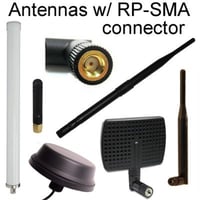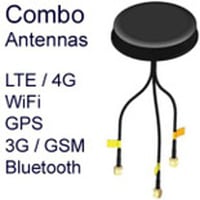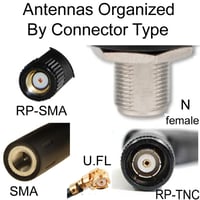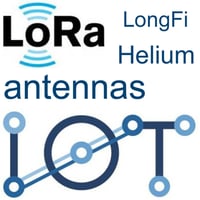ZigBee Antennas
ZigBee Antennas for Internet of Things (IOT) Applications
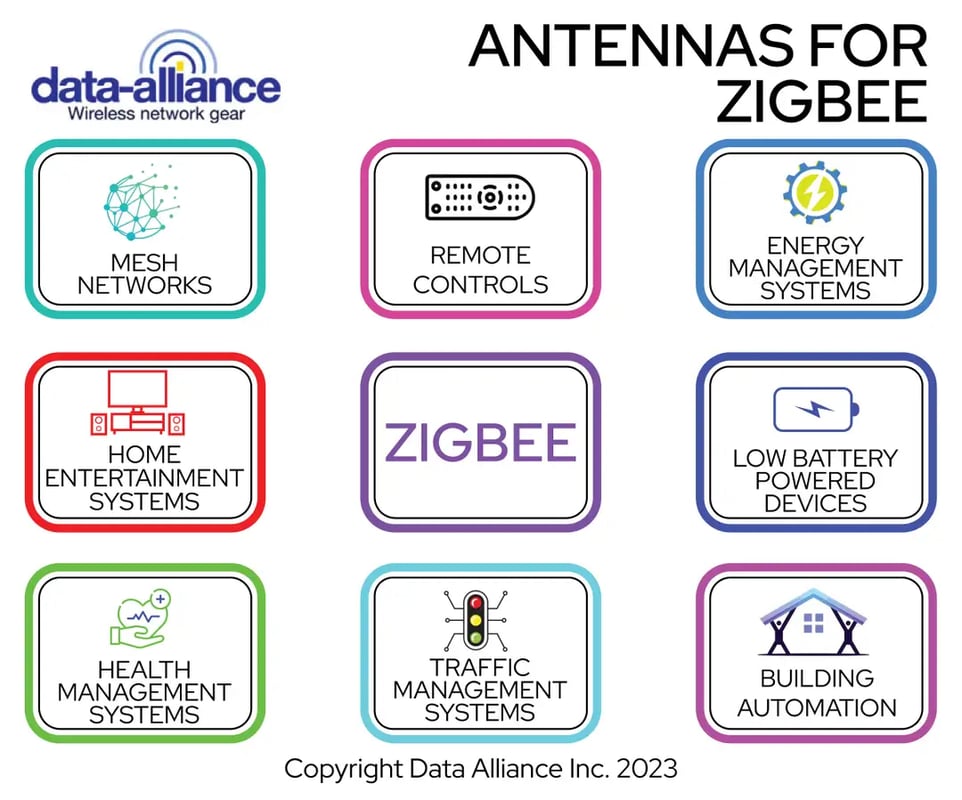
ZigBee is a low-cost wireless technology used for short-range, low-power radio communication. ZigBee devices are almost exclusively limited to low bandwidth (1MHz) personal area networks. ZigBee can be integrated into a mesh network for long-range data transfers.
ZigBee is a wireless personal area network (WPAN) which is characterized by being low-power, low-data rate and operating at close proximity. It does not require line of sight. Transmission distances are typically within 10 to 100m. ZigBee is named after the distinctive movements of honeybees.
Most commercial ZigBee devices operate at 2.4GHz, although some devices run on other ISMbands such as 900MHz and 868 MHz frequency bands. ZigBee has a data transmission rate of 250 Kbit/s, and a maximum range 10 - 30 meters at a power consumption rating of 1mW at low and 100mW at peak.
ZigBee has many similarities to Bluetooth but is simpler and cheaper to operate.
- Simpler and lower-cost alternative to Bluetooth for IoT (Internet of Things) applications: ZigBee's low power consumption, low data rates, and short range make ZigBee ideal for use in low power communication devices in close proximity.
- ZigBee uses the same frequency band as Bluetooth: 2.400 to 2.484GHz.
- A ZigBee antenna can be obtained as a Printed Circuit Board (PCB) antenna or omni directional external antenna with operational frequency range of 2.400 to 2.484GHz.
XBee is a radio communication device developed by Digi International for low power point-to-point and star transmission; suitable for ZigBee technology. It consists of a 20-pin through-hole-mount interface or 38-pad surface mount, and a U.FL jack or RP-SMA antenna. Variations in power consumption, RF frequency, and antenna type depend on the various brands of the product.
ZigBee is commonly used in mesh networks and in low power battery powered devices. Its low cost for transmission makes it ideal for IoT (Internet of Things) devices, especially in close range. Other Popular applications of ZigBee include:
- Building automation
- Energy management systems
- Home entertainment systems
- Remote controls
- Traffic management systems
ZigBee Antennas: A Comprehensive Guide
ZigBee antennas for low-rate wireless personal area networking
ZigBee antennas are designed to support ZigBee networking as outlined in the Institute of Electrical and Electronics Engineers (IEEE) wireless networking standard IEEE 802.15.4. They are a heterogeneous group of antennas and vary structurally, in terms of types, connectors, and radomes as detailed further on. The variety of high-quality ZigBee antennas available means that an antenna can be precisely matched to the applications for which the ZigBee network is being used. A properly functioning ZigBee antenna will be resonant at one of the key frequencies at which ZigBee operates and able to transmit and receive low power, low data rate ZigBee transmissions with the minimum signal loss. They can be internalized ZigBee antennas that are integrated within ZigBee-compatible devices or controllers or an external ZigBee antennathat can be installed for optimal network coverage when and where required. They may be proprietary ZigBee antennas, specifically designed for this purpose, or generic antennas with a suitable fundamental frequency.
Our extensive selection of ZigBee antennas is manufactured using quality fabrication methods and materials. All ZigBee antennas for sale are compliant with the EU Restrictions on Hazardous Substances (RoHS) directive and relevant conflict minerals legislation such as the Dodd-Frank Act Section 1502 and the European Conflict Minerals Regulation.
About ZigBee
ZigBee is a wireless networking protocol that provides specifications for the arrangement and functioning of low-power, low-data rate mesh networks that are used in a range of settings. Intriguingly, it is named after the characterized zig-zag movements of honeybees as they return to their hive, which the ad-hoc, self-organizing function of ZigBee networks is likened to. This type of network is known as a Low-Rate Wireless Personal Area Network (LR-WAN) and is known for its low energy consumption, use of battery power, and ready scalability. Its capabilities lend it to being used in a range of applications that require long-term embedded functionality. ZigBee networks are frequently used to undertake wireless monitoring and control functions, often relying on battery power.
The development of ZigBee started in the late 1990s, building on the IEEE 802.15.4 protocol, with the first version of the proprietary standards published in 2002. It is overseen by the ZigBee Alliance, an organization that brings together expertise from over 500 industry and technology leaders, including Amazon, General Electric, and Comcast. ZigBee takes the physical layer and Media Access Controls (MAC) from the IEEE protocol and adds:
- A network layer
- An application layer
- The ZigBee Device Object (ZDO)
ZigBee is continually refined and updated with commercial and manufacturer-defined application objects as directed by their industry partners. ZigBee chipsets are integrated into microcontrollers and other objects for low-latency connectivity between networked objects.
ZigBee antennas are 2.4 GHz antennas
ZigBee operates at several operating frequencies, but the most commonly used frequency band by ZigBee antennas and devices spans 2400 MHz to 2483.5 MHz. This is a license-free frequency band known as the 2.4 GHz frequency band was initially designated by the International Telecommunications Union for Industrial, Scientific, and Medical (ISM) purposes, but has now been appropriated for supporting wireless networks such as ZigBee. This frequency band is particularly favored for wireless networks such as Personal Area Networks because of the range and good penetration of carrier signals at these frequencies of walls and building materials in indoor settings. Though alternate frequencies are available, the advantages of 2.4 GHz for operating ZigBee mean that external 2.4 GHz antennas predominate as ZigBee antennas. With the right connectors, a 2.4 GHz antenna can be used interchangeably with commercially available ZigBee kits and systems for optimal coverage due to selected receiver sensitivity and transmission power.
Not all 2.4 GHz antennas can be used for ZigBee. ZigBee antennas must perform in line with the 802.15.4 protocol which specifies:
- A receiver sensitivity of -85dBm at 2.4 GHz
- Limitation of transmit power for ZigBee antennas following the regulations of the Federal Communications Commission (FCC) and equivalent regulatory bodies in other countries.
Alternative frequencies for ZigBee antennas
ZigBee is also operative in two other ISM frequency bands:
- 902 to 928 MHz (in the Americas and Australasia)
- 868-868.6 MHz (in Europe)
Sub-gigahertz wireless deployments of ZigBee offer long-distance, low-energy solutions for supporting ZigBee data transfer due to their greater range, penetration, and resilience against fading than 2.4 GHz. Though data rates are lower (20 to 40 kbps at the lower frequencies mentioned) than those achieved at 2.4 GHz, there is far less opportunity for interference, and the lower ISM frequency bands can be used for battery-powered devices over years of in-situ deployment.
Key types of antenna for ZigBee networks
External ZigBee antennas can be added at every level of a ZigBee network. Internal ZigBee antennas can also be connected to devices with relevant expertise. When attached to a ZigBee coordinator or hub device, they will boost the coverage and performance of the entire network especially if used in a building with multiple floors. External antennas may also be found attached to ZigBee repeaters or wireless boosters. These antennas will carry standard coaxial connectors such as SMA, RP-SMA, N-type, and TNC connectors for a stable mechanical and electrical connection. Adapters and pigtails can be used to form a reliable connection between a circuit board and an external antenna. These are the main types of ZigBee antenna:
[A] Omnidirectional ZigBee antennasprovide 360-degree coverage around the longitudinal axis of the antenna. They provide room or building-wide coverage, especially if ceiling-mounted. Choose from robust designs including whip ZigBee antennas, dipole ZigBee antennas, rubber ducky ZigBee antennas, and puck antennas that are shaped like a hockey puck and ideal for low-profile through-hole mounting.
[B] Directional ZigBee antennas transmit and receive radio frequency energy in a specific direction meaning that it can be focused for greater gain. When used selectively in a ZigBee network they provide targeted amplification and focus of the network in a specific area. Wall-mounted panel ZigBee antennas are an example.
[C] Chip ZigBee antennas are an option for adding an internalized ZigBee antenna to a device. These antennas are great for adding ZigBee connectivity to hobbyist electronic projects or completing repairs or upgrades to devices. PCB-mounted ZigBeeantennas will be lower power and of limited range in comparison to the external antennas that are available. Trace ZigBee antennasare another type of low-profile internal ZigBee antenna. They are made from a special geometric foil that is printed directly onto a PCB, with repetitions of the pattern to increase the antenna’s overall gain.
ZigBee network structure
As mentioned about the operation of ZigBee is underpinned by the IEEE protocol 802.15.4, which specifies a relatively simple LP-WAN with coverage or range of 10 meters and data rates of up to 250 kbit per second when the 2.4 GHz frequency band is used. The lower levels of the network structure specified support continuous connectivity with low energy consumption and generic communication that suits the monitoring applications ZigBee is usually used for. The 802.14.4 PHY layer specifications cover data transmission, the transceivers used, and channel selection, with up to 16 channels available for ZigBee to use at 2.4 GHz. Generally the lower the data rate of the network, the lower the power consumption. Notable lower-level features of the ZigBee network include:
- Mechanisms to reduce the wastage of channel bandwidth such as Guaranteed Time Slots (GTS). Channel slots for transmission are allocated to particular nodes in the network according to a particular allocation strategy.
- The use of Carrier Sense Multiple Access (CSMA) with collision avoidance is a key collision avoidance strategy. CSMA is a commonly used multiple access method which involves participating nodes avoiding data collisions by only transmitting once they have sensed that a particular channel is idle. When transmitting, participating nodes are designed to transmit their entire data packet at once, again to reduce the potential for collisions if transmissions are protracted or intermittent. It is useful in ZigBee as though nodes may have connectivity with the controller, their arrangement may mean they do not all have sight of each other.
- Sensor networks used for domestic or industrial applications are inherently security-sensitive, especially if the network is controlling physical locks, alarms, or lighting. 802.14.5 supports secure communications by specifying a link-layer security package. Link encryption involves routine encryption (scrambling) of data as it is transferred between two nodes in the ZigBee network. Data will be encrypted as it leaves the transmitting node and decrypted by the receiving node. If data is passed between multiple nodes, it must be encrypted and decrypted at every stop on its relay, potentially with varying encryption keys at each step, for more robust security overall.
- Power management is also integrated into the functioning of the network with monitoring of energy consumption, data rates, and the speed and quality of links within the network.
ZigBee network structure and components
ZigBee’s proprietary higher-level protocol specifies its characteristic network layer. Participating devices or nodes are either full-function devices (FFD) or reduced function devices (RFD), depending on the ability to coordinate the network. All participating nodes in a ZigBee network transmit and receive using the same channel. Integrated or external ZigBee antennas are critical for relaying data between nodes and providing overall network coverage. Each network will have at least one personal area network (PAN), controller. ZigBee networks arrange their nodes into one of three key network topologies. The type of network implemented will depend on the requirements of the application. For example, consumer-level home automation systems often use a star topology.
- Star networks are a standard network topology, where there is a central node, access point, or PAN controller which connects with surrounding end-point or spoke nodes. The central controller is usually reliant on mains power, whereas the subordinate nodes may be battery powered. In a star network, peripheral nodes have connectivity with the central hub but not with one another. Extended star networks involve the integration of repeater nodes between end-points and the hub which may have great functionality.
- Mesh or peer-to-peer networks: are characterized by the scalable, non-hierarchical spread arrangement in which points of connectivity or nodes have multiple connections with one another and work together to propagate data through the network. Ad-hoc, self-organizing mesh networks have been found to be advantageous as they can remain operable if individual nodes fail, with data being re-routed via alternate nodes.
- Tree networks: also known as a star-bus network this topology has a backbone connection, or trunk, with branches that give rise to individual star networks. The offshoot star networks can only have connectivity with each other via the trunk connection. Cluster tree network topologies are a variant of mesh networks where a notable proportion of participant devices are fully functional and able to perform the role of coordinator.
There are standard components that routinely make up a ZigBee network used in home or industry. A 2.4 GHz ZigBee antenna can be used to enhance the connectivity and performance of any of these hierarchical devices.
- ZigBee Coordinators (ZC). These are also known and sold to consumers as ZigBee hubs. This device is responsible for forming and managing the network, performing the role of PAN controller and there is always one per network. It also performs the role of an access point or router. ZCs will carry critical identification management software such as security keys, PAN ID, and the trust center. Only a ZC can accept new devices to join a ZigBee network and will stringently coordinate the pairing process with new devices. They will have a robust and accessible user interface, especially when used as a domestic hub.
- ZigBee Routers (ZR). ZR devices are fully functional devices that are capable of both transmitting and receiving data. This means that they can pass on data from both the ZC and participating nodes and in some cases, they can run applications. They do not have a duty cycle and are always on and ready to move data, meaning they have higher power consumption and may also require mains power. In smaller one-hop networks, ZRs are not usually required. They are of particular use in complex or large-scale networks such as those used by the Internet of Things (IoT).
- ZigBee End Devices (ZED). These are end-point nodes that can communicate with ZCs or ZRs but not amongst themselves. They are reduced function devices that are most likely to be battery-operated and can be installed away from a mains connection. ZEDs have minimal functionality and will sleep if not actively transmitting data which means that they can conserve their power.
Key ZigBee applications
Because ZigBee offers simple, scalable low-energy networking it can be adapted for use in a range of applications that require sensor-based monitoring and control. ZigBee can be used to equip objects with connectivity and network them creating an excellent example of the Internet of Things (IoT) in action. In all applications the use of a ZigBee antenna is critical. Here are some of the leading ZigBee applications.
- Home automation is probably one of the most common consumer applications of not only ZigBee but the Internet of Things. Smart home solutions operated using ZigBee networking include lighting, Heating Ventilation, and Air Conditioning (HVAC), and appliances like coffee makers or pet food dispensers. A ZigBee hub or controller can be paired with compatible devices that send a join request and are accepted to the hub's Trust Center. Home automation is a heterogeneous marketplace that lacks open source technology, but ZigBee has differentiated itself as an established technology for home automation with high interoperability and longevity.
- Building automation and security can be used for a range of properties as part of a Building Management System (BMS), that oversees systems within a building such as its heating or occupancy. ZigBee sensors can be used for real-time monitoring of ambient temperature, whether windows are open or closed or the position of locks. Fire safety systems can also be integrated with sensors that can detect smoke. ZigBee networks used for smart buildings are thought to have the potential of saving energy due to judicious control of heating, cooling, and lighting.
- Industrial and M2M applications utilize the ability of ZigBee to form effective wireless sensor networks that can fine-tune manufacturing conditions and deliver timely alerts where system dysfunction or supply chain faults may occur. As the data rates and energy consumption are low for ZigBee, industrial deployments can be very cost-effective. ZigBee is being positioned as the standard for IoT networking with ZigBee almost a billion ZigBee chipsets being integrated into industrial equipment in diverse sectors like agriculture, retail monitoring, and utility metering. Global availability and use of the 2.4 GHz frequency band makes deploying ZigBee across international boundaries for warehousing or logistics projects simpler.
Frequently asked questions for ZigBee antennas
What are the ZigBee channels?
At 2.4 GHz, there are 16 distinct channels for ZigBee which are each 5 MHz wide. They are numbered from 11 to 26. Channel selection is important with ZigBee as the ZigBee channels overlap the 11 to 14 WiFi channels and can cause interference where both channels are used concurrently. It is always best to avoid settling for the default channel settings and choosing a ZigBee channel that is clear of WiFi or other wireless networking channels in use. ZigBee channels 15, 20, and 25 do not overlap with WiFi.
Here is a list of the ZigBee channels:
|
ZigBee channel |
Frequency (MHz) |
|
1 |
2405 |
|
2 |
2410 |
|
3 |
2415 |
|
4 |
2420 |
|
5 |
2425 |
|
6 |
2430 |
|
7 |
2435 |
|
8 |
2440 |
|
9 |
2445 |
|
10 |
2450 |
|
11 |
2455 |
|
12 |
2460 |
|
13 |
2465 |
|
14 |
2470 |
|
15 |
2475 |
|
16 |
2480 |
What are the differences between ZigBee and WiFi?
WiFi is by far the most well-known and widespread wireless networking technology and at 2.4 GHz it is highly to be encountered while deploying a concurrent ZigBee network. It is important to remember that although ZigBee and WiFi use the same frequency band they are two very distinct types of networks. Here are the key differences between ZigBee vs WiFi:
- ZigBee is designed for monitoring and control applications; WiFi is primarily for high speed, high throughput wireless internet connectivity.
- ZigBee moves smaller amounts of data (up to 250kbps), over shorter distances
- WiFi has much higher data rates, up to 1 Gbit per second with WiFi 5 or 6.
- ZigBee has far lower energy consumption and participating devices can be battery powered for prolonged periods.
- WiFi predominantly uses a star network topology whereas ZigBee networks are often mesh networks.
- WiFi is perceived as easier to set up, especially in domestic settings and networked devices can be added and removed quickly.
- WiFi has few of the compatibility issues that may be encountered with WiFi.
What are the differences between ZigBee and Bluetooth?
There are many similarities between Bluetooth and ZigBee which are widely used for low energy, peer to peer networking. Both ZigBee and Bluetooth are used to create Personal Area Networks and operate at 2.4 GHz. Notable differences between the two mesh networks (IEEE 802.15.1 and 802.15.4) include:
- ZigBee supports battery-powered devices that are deployed on a long term basis. Bluetooth devices usually require frequent recharging.
- Bluetooth is mainly operated over shorter distances than those of ZigBee and has less penetration of walls within buildings.
- ZigBee's data transfer rates are far lower than those of Bluetooth which has a bit rate of 345 kbps. Bluetooth can be used to share files between devices, sharing much larger data packets at a time.
- The modulation techniques used by the two networks are different, with ZigBee using offset quadrature phase-shift keying and Bluetooth adopting Gaussian Frequency Shift Keying.
- ZigBee is highly scalable with functioning networks capable of supporting over 60,000 nodes versus 8 for Bluetooth.
These key features of ZigBee make it a particularly effective choice for IoT applications compared to its main competitors at 2.4 GHz.
Antenna Cables and Connector Types: ZigBee antennas can be connected to its corresponding device module with the antenna cables including the following types:
-
- MHF4 cable to connect to a MHF4 connector on the module or Printed Circuit Board. If your antenna of choice has an RP-SMA connector (or cable to an RP-SMA connector): Typically, you will use a MHF4 to RP-SMA cable to connect to the Bluetooth module.
- Use a U.FL cable to connect to a U.FL jack or IPEX jack on the PCB (Printed Circuit Board) or module. If your antenna of choice has a cable to an RP-SMA connector (or an RP-SMA connector directly on the antenna): Use a U.FL to RP-SMA cable to connect to the RP-SMA-female jack on the ZigBee module.
- To connect your antenna to an RP-SMA jack on a ZigBee module: Use a RP-SMA extension cable.
ZigBee is a key wireless networking technology for scalable IoT and home automation deployments and delivers robust and reliable performance at 2.4 GHz. Integration of the right ZigBee antennas when setting up a network is critical to obtaining the coverage needed for the network to operate properly. Internal and external ZigBee antennas provide flexible solutions for achieving this, both in industry and in the domestic setting.
LEARN MORE:
- More on ZigBee antenna networking
- The Internet of Things
- 2.4 GHz antennas

